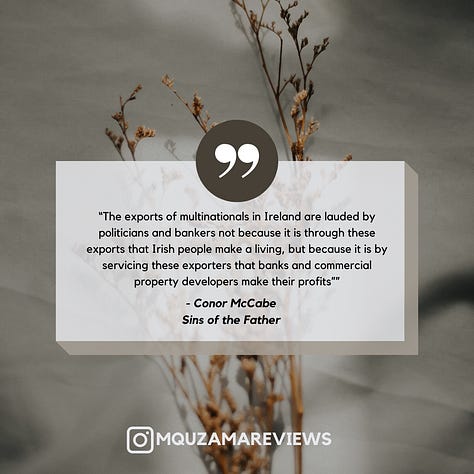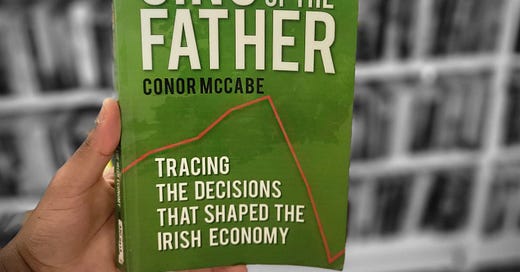Sins of the Father: Book Review
A review of Conor McCabe's 'Sins of the Father: Tracing the Decisions that Shaped the Irish Economy'
It is often forgotten that Ireland, together with a not-so-insignificant chunk of the world, was also colonised by Britain, with some even arguing that it was the prototype for British imperialism. The obvious question is then, how did Ireland manage to develop, unlike other colonies? How is it so wealthy (at least according to GDP per capita)? Has it always been like this? When did these changes happen? Does its colonial past also dictate its current economic structure? How is this structure? And most importantly, is the reality as rosy as macroeconomic numbers suggest?
Sins of the Father goes an impressive distance in trying to answer these questions, especially the latter ones. Put briefly, the book is an in-depth discussion of the historical processes and policy decisions behind the contemporary structure of the Irish economy and the consequent distribution of economic power. The author, Conor McCabe, does this by looking at the evolution of housing, agriculture, industry and finance, culminating in how the structures of these spheres foregrounded the financial crisis and the response to it.
Throughout McCabe’s analysis of housing, agriculture, industry and finance, I noticed a faint thread that ran through the trajectory of all of these sectors. For the period around independence, there seems to be clear remnants of colonial architecture being carried over. Examples of these are the continued centrality of the cattle industry (catering to Britain) and its interests in the Irish economy and more clearly, the tying of their currency to the British Sterling.
“ [Ireland’s] role was to provide agricultural produce for the industrial centres of Britain, and this was done mainly in the form of live cattle export” - pg. 57
“Political independence had not led to monetary independence from Britain” - pg. 127
The period that follows this is typified by failing efforts to address imbalances in the Irish economic and social system, either due to the nature of the approach (a reliance on private enterprise to solve the issues) - e.g. use of private initiatives to address the prominence of slum dwellings, or the inadequacy of the approach (reluctance to employ structure-changing policies) - e.g. failure to reorient or diversify the economy away from the cattle industry or the failure to establish an independent currency, detached from Britain.
The 1930s, McCabe highlights, (with the change in government to Fianna Fail), saw a shift in policy. From the implementation of land reforms (1933 Land Act) to a concerted move to eradicate slum housing (1931 Housing Act), this epoch is an outlier in the history of Irish economic policy. However, McCabe argues that these policies, especially the land reforms, were not as effective as may seem pointing out that the rigid incentive structures (unchanged with the changing policy direction) consolidated the primacy of the cattle industry, instead of delivering the desired diversified economic base. I must admit that I found his critique of this period’s policies rather harsh given the significant improvements in landholdings and living conditions that this period engendered. Could it have been better? Probably. But I do think, from the little I read about the period, that things could have been much much worse.
The exit of the Fianna Fail government realigned economic policy with the earlier dependence on the private sector, exacerbated by the entry of foreign direct investment in the 1950s. Thus, by the 1990s to 2000s, Ireland was a neoliberal’s paradise - with the prominence of speculation (mostly seen in real estate), tax breaks for giant multinational corporations and limited regulation.
Industry & Finance
Of course, my favourite part of the book is the discussion of Ireland’s industry and financial sector, specifically the relationship between the two. It is widely known that the defining feature of Ireland’s economy is how it is dominated by international capital with Apple, Facebook and Google all having a significant presence in Dublin. But how did Ireland get here? (*cough* tax haven *cough*)
McCabe finds this answer in the financial architecture adopted post-independence. After the end of British rule, Ireland chose to tie its currency to the Sterling. The implications of this, McCabe argues, was a weak industrial base, as the pegging of their currency to a stronger one not only made imports cheaper but maintaining this parity necessitated the suppression of internal demand (to reduce imports) and thus required limited dispersion of credit. On the other hand, because the currency was overvalued, and almost interchangeable with Sterling, it was easier for the banks to simply keep their funds in Britain, guaranteeing relatively risk-free and stable returns. So, under the same system that scampered the growth of local industries with cheaper imports and limited loans, banks were not only unscathed but they were making a (risk-free) killing!

Within this framework, when the need to industrialise became glaring (with waning demand from Britain & need to address the trade deficit), the only route towards industrialisation was to outsource it. Thus, in the 1950s, capitalising on its preferential access to the British market, Ireland leaned heavily on FDI to spur its diversified industrialised growth. To facilitate this, among other things, Ireland created a ‘favourable tax regime’ (read: tax haven), which offered convertibility of currencies, relaxed regulations and full repatriation of profits.
Although McCabe states that the insertion of Ireland into the European Common markets heightened this process, this was one of the few mentions of the economic implications of membership into the eurozone. I am not sure if I somehow missed this, but given the rich literature on the financial implications of absorption into the orbit of the euro, I would have loved at least a brief discussion of the same on Ireland, to contextualise the current economic system within its wider governance structure.
But how well have these FDI-centric policies performed in restructuring and bolstering the Irish economy?
Not well at all! McCabe argues that the strategy has failed to achieve its claimed targets of employment and developing an industrial base. It had startlingly low levels of employment and even lower linkages to the broader economy since “what they need they import, and what they produce they export”, and in an attempt to attract them, the state had lowered their taxes meaning they do not get much tax revenue either. For context, in 2008, multinational corporations accounted for 80% of all merchant exports, but only 7% of total employment.
This raises the question as to why such a policy has continued to be maintained then? McCabe argues that the flurry of FDI led to increased business for intermediary services, those involved in real estate and financial services, as they facilitated the increasing levels of imports and exports. Matter of fact, most of the reported sustained job growth with the advent of FDI has been concentrated in these sectors.
“The exports of multinationals in Ireland are lauded by politicians and bankers not because it is through these exports that Irish people make a living, but because it is by servicing these exporters that banks and commercial property developers make their profits” - pg. 89
The book’s analysis reminded me so much of Ndongo Samba Sylla’s discussion of the CFA Franc Zone. Similar to Ireland, they also pegged their currency to the one of a country of supposed strategic importance to them - France. They also had to endure an overvalued currency, foreign companies repatriating most of their profits at the expense of local investment, and a lack of control of their monetary policy and credit creation, limiting their sustained developmental prospects.
Therefore, the case of Ireland becomes extremely interesting when transposed with the policy direction for current African governments who seem to think FDI will solve their continued issue with unemployment and a lean industrial base. What McCabe shows here, also seen in arguments made by Rao Chalapti and Biswajit Dhar is that FDI does not necessarily translate to job creation or expertise and technology transfer.
Who Benefits Then?
I must admit that McCabe’s writing in this book was not my cup of tea. It wasn’t because it was full of jargon or anything but it often oscillated between different periods in its discussions which sometimes made it hard for someone who was not familiar with the political history of Ireland to follow.
Despite this, the book offers a compelling case against Ireland’s economic model, stressing that unless you are a banker, landlord, politician or somewhere close to these, you are not benefiting from it. If the global south is losing tax revenue that can fund its much-needed social infrastructure, and residents in the tax havens are not reaping any rewards either, it becomes clear that globally, as also argued by ICRICT, there is an urgent need “to bring about significant reform of the international corporate taxation system. An alternative to the current tax regime.
It is in this discussion of alternatives that I also found the book somewhat lacking. Or maybe it was beyond the scope of the book? Anyway, I would have loved a discussion of the outlines of what an alternative path could have been for Ireland at critical points in its economic history. The lack of this discussion makes me question whether the adopted policy choices were the only ones that were feasible politically and economically. For example, in the CFA Franc Zone, any attempts at an alternative economic structure were thwarted either economically, politically and at times militarily. This concern becomes more prominent when the economic requirements of EU membership are brought into the picture. I would have loved a discussion similar to the one in Democratizing Finance, which does not only discuss policy proposals but also bakes in the political and economic contestations of implementing them.
Overall, I learnt a lot from this book. It is a candid and comprehensive excavation of the political foundations of Ireland’s economic architecture. Although it did not answer some of the burning questions I had, it raises its own key questions for contemporary Ireland with the looming elections. It asks “Who is daring enough to imagine a truly new future for an Ireland that does not continue to only serve the elite few?”











